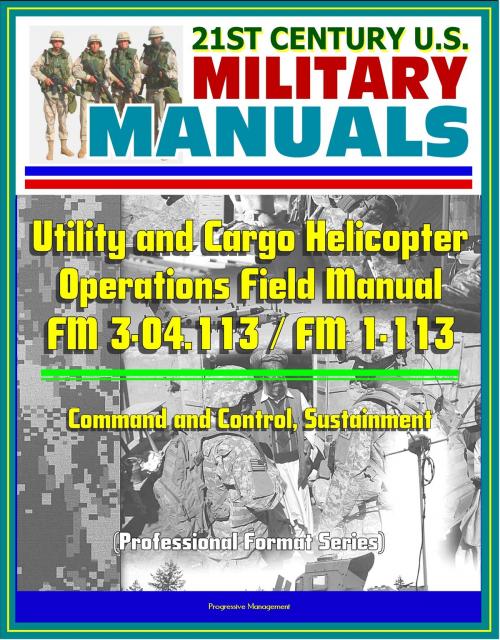21st Century U.S. Military Manuals: Utility and Cargo Helicopter Operations Field Manual - FM 3-04.113 / FM 1-113 - Command and Control, Sustainment (Professional Format Series)
Nonfiction, History, Military, Aviation| Author: | Progressive Management | ISBN: | 9781301836321 |
| Publisher: | Progressive Management | Publication: | November 17, 2012 |
| Imprint: | Smashwords Edition | Language: | English |
| Author: | Progressive Management |
| ISBN: | 9781301836321 |
| Publisher: | Progressive Management |
| Publication: | November 17, 2012 |
| Imprint: | Smashwords Edition |
| Language: | English |
Professionally converted for accurate flowing-text e-book format reproduction, this FM is the Army's doctrine for how to fight and sustain assault helicopter battalions (AHBs) and general support aviation battalions (GSABs). The operational concepts described in this manual are based on Army doctrine as established in FM 1, FM 3-0, and FM 3-04.111. Emphasis is placed on modular force structure and the enhanced operational capability provided by Army aviation transformation.
FM 3-04.113 applies to regular Army and reserve component units. It builds on collective knowledge and experience gained through recent operations, numerous exercises, and the deliberate process of informed reasoning. This publication is rooted in time-tested principles and fundamentals, while accommodating new technologies, and evolving responses to the diverse threats to our national security. This manual also assists Army proponent schools in teaching utility and cargo helicopter operations.
FM 3-04.113 lays out the "how-to" of assault and GS helicopter organizations, missions, command and control (C2), tactical employment, and sustainment. It describes the responsibilities and duties of key personnel during training, operations, and combat. This manual is authoritative but not considered inflexible. Each situation in combat must be resolved by an intelligent interpretation and application of the doctrine set forth herein. Standardized battalion and company operations are necessary for effective employment of aviation battalion task forces (ABTFs). To this end, like companies should follow similar operational and employment procedures.
As a bonus, this reproduction includes the complete 2012 Army Leadership manual (FM 6-22), which describes the Army's view of leadership, outlines the levels of leadership (direct, organizational, and strategic), and describes the attributes and core leader competencies across all levels. The principal audience for ADRP 6-22 is all leaders, military and civilian. Trainers and educators throughout the Army will also use this publication. Commanders, staffs, and subordinates ensure their decisions and actions comply with applicable United States, international, and, in some cases, host-nation laws and regulations. Commanders at all levels ensure their Soldiers operate in accordance with the law of war and the rules of engagement. It establishes and describes the leader attributes and core leader competencies that facilitate focused feedback, education, training, and development across all leadership levels. An ideal Army leader has strong intellect, physical presence, professional competence, moral character and serves as a role model. An Army leader is able and willing to act decisively, within the intent and purpose of superior leaders and in the best interest of the organization. Army leaders recognize that organizations, built on mutual trust and confidence, successfully accomplish missions.
Professionally converted for accurate flowing-text e-book format reproduction, this FM is the Army's doctrine for how to fight and sustain assault helicopter battalions (AHBs) and general support aviation battalions (GSABs). The operational concepts described in this manual are based on Army doctrine as established in FM 1, FM 3-0, and FM 3-04.111. Emphasis is placed on modular force structure and the enhanced operational capability provided by Army aviation transformation.
FM 3-04.113 applies to regular Army and reserve component units. It builds on collective knowledge and experience gained through recent operations, numerous exercises, and the deliberate process of informed reasoning. This publication is rooted in time-tested principles and fundamentals, while accommodating new technologies, and evolving responses to the diverse threats to our national security. This manual also assists Army proponent schools in teaching utility and cargo helicopter operations.
FM 3-04.113 lays out the "how-to" of assault and GS helicopter organizations, missions, command and control (C2), tactical employment, and sustainment. It describes the responsibilities and duties of key personnel during training, operations, and combat. This manual is authoritative but not considered inflexible. Each situation in combat must be resolved by an intelligent interpretation and application of the doctrine set forth herein. Standardized battalion and company operations are necessary for effective employment of aviation battalion task forces (ABTFs). To this end, like companies should follow similar operational and employment procedures.
As a bonus, this reproduction includes the complete 2012 Army Leadership manual (FM 6-22), which describes the Army's view of leadership, outlines the levels of leadership (direct, organizational, and strategic), and describes the attributes and core leader competencies across all levels. The principal audience for ADRP 6-22 is all leaders, military and civilian. Trainers and educators throughout the Army will also use this publication. Commanders, staffs, and subordinates ensure their decisions and actions comply with applicable United States, international, and, in some cases, host-nation laws and regulations. Commanders at all levels ensure their Soldiers operate in accordance with the law of war and the rules of engagement. It establishes and describes the leader attributes and core leader competencies that facilitate focused feedback, education, training, and development across all leadership levels. An ideal Army leader has strong intellect, physical presence, professional competence, moral character and serves as a role model. An Army leader is able and willing to act decisively, within the intent and purpose of superior leaders and in the best interest of the organization. Army leaders recognize that organizations, built on mutual trust and confidence, successfully accomplish missions.















